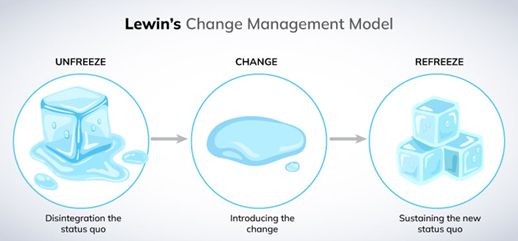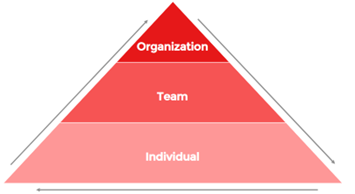
Table of Contents
Too often change projects fall short, and that results in disengagement and poor performance. By understanding change better, we improve the chances of making the right change decisions and implementing them successfully.
This is an article in our series about change in organizations. For more information about this series visit our Change Resources page.
Drivers for Change in An Organization
One helpful way of thinking about change was introduced by Kurt Lewin and is now known as the Lewin Change Model. It defines the three required phases for any change to occur and is analogous to ice cubes:
- The current state is solid and firm, like ice cubes. This is the existing status quo. Before anything can happen, energy must be applied to soften and melt the ice.
- The transition state is like water, malleable and flexible, able to be shaped into the desired new form.
- The future state is a refreezing; solidifying the new status quo in the desired form.

By understanding these three distinct steps, leaders can know where they are in the process of change and where they need to go next. Between phase one and two, the strategy is to ‘melt’ current processes, habits, and mechanisms. Between two and three, the focus is on establishing and solidifying new skills and methods. Understanding these phases helps to reduce resistance to change in your organization.
Sean Fitzgerald explains The Lewin Change Model
Scaling Change
As leaders, we must recognize the scale of any change so we can tailor the planning, energy, and focus accordingly. Switching a vendor for office supplies might be a minor change - quick and likely handled by just one individual or team. At the other end of the scale could be a major strategic change like entering a new market or launching a new product line. These types of changes will require multiple departments, significant investment, and should be carefully planned and resourced for their scope.
focus accordingly. Switching a vendor for office supplies might be a minor change - quick and likely handled by just one individual or team. At the other end of the scale could be a major strategic change like entering a new market or launching a new product line. These types of changes will require multiple departments, significant investment, and should be carefully planned and resourced for their scope.
Furthermore, as mentioned in our last article in this series , leaders must be mindful of the number and scale of simultaneous change projects going on in their organization. Failure to see change through to the end leaves you with a bunch of unfinished projects or "puddles." Puddles aren't helpful in your business.
Knowing When to Change
Ideally, decisions to make a change would occur proactively, and because of either dissatisfaction with the current state, or a compelling desire to move to a new future state. This is the tension or motivation for change.
Think about people who move from one employer to another. This decision occurs because they are dissatisfied with their current employer or job, have identified a more desirable employer or job, or a combination of both.
For companies, proactive change decisions should be outputs of a structured strategic planning business process. Strategic decisions for any organization are the job of the senior leadership team and are in response to identified external opportunities and threats, and internal strengths and weaknesses (the well-known SWOT approach) of the company.
Change projects of this type are Strategic Priorities and should be steps towards the organization’s vision. In fact, all change decisions should be guided by the company vision, and aligned to the established true north just like a compass guides a seafaring ship captain.
It’s important to recognize too that a decision not to change is sometimes the best choice. Entrepreneurs are notorious for chasing “shiny objects.” Disciplined business execution is about choosing the right handful of strategic priorities every quarter.
“If you have more than three priorities, then you don’t have any.”
- Jim Collins
Benefits of Change Management in An Organization
As leaders, we are ultimately the ones who are responsible for change management in an organization. As such, change management is one of the most important skills for leaders today. Without change, our companies will wither and die.
Business case studies are littered with examples of companies that refused to or couldn’t change quickly enough. Kodak, Nokia, Nortel, and Blockbuster are just some of the casualties of inability to change. To succeed, leaders must understand the benefits of change in an organization. They must also leverage the mechanisms of change, and skillfully steward their strategic change initiatives.
If you’d like to learn more about change or other ways you can take the simpler path to creating a great business, connect with us or consider attending one of our upcoming leadership events.



